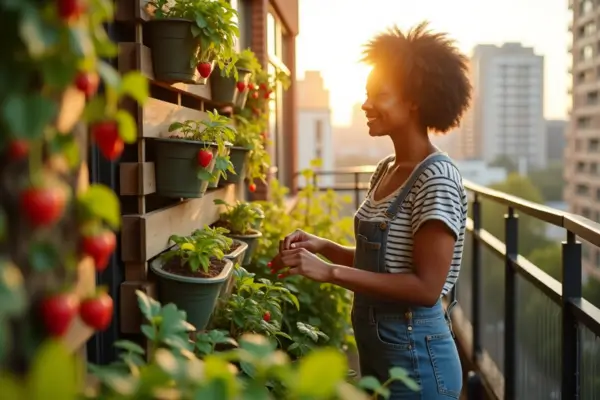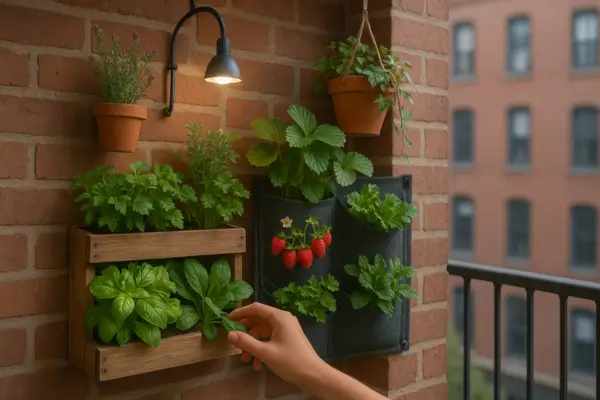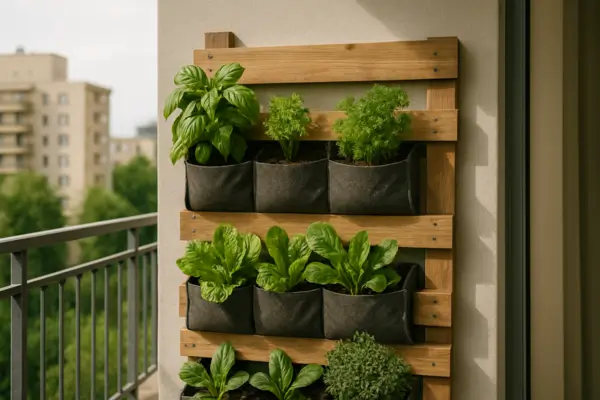Introduction
Living in a city doesn’t mean you have to give up on growing your own food or creating a green oasis. Vertical gardening is a brilliant solution for urban dwellers with limited space, and it’s a perfect entry point for permaculture newbies. By growing plants upward instead of outward, you can transform small balconies, walls, or even indoor spaces into thriving edible gardens.
Why is vertical gardening ideal for beginners?
✔ Saves space – No backyard? No problem! Grow herbs, veggies, and flowers on walls, railings, or hanging structures.
✔ Low maintenance – Many vertical systems use self-watering planters or efficient irrigation, reducing daily chores.
✔ Sustainable – Repurpose everyday items (like bottles, pallets, or shoe organizers) to minimize waste.
✔ Boosts urban biodiversity – Attracts pollinators and improves air quality in concrete-heavy environments.
If you’re looking for easy vertical garden ideas for urban permaculture newbies, you’re in the right place! Let’s explore simple, creative ways to start your own green wall—no prior gardening experience required. 🌿
1-Why Choose Vertical Gardening for Urban Permaculture?
If you’re new to urban gardening, you might wonder: Why go vertical? The answer lies in its incredible efficiency and adaptability for city living. Here’s why vertical gardening is a game-changer for urban permaculture newbies:
1. Maximizes Small Spaces
City dwellers often struggle with limited ground space—but with vertical gardens, every inch counts! Whether you have a tiny balcony, a blank wall, or just a sunny windowsill, you can grow food and flowers upward instead of outward.
- Perfect for: Apartment balconies, fire escapes, rooftops, and even indoor walls.
- Example: A single pallet or hanging shoe organizer can hold as many plants as a small garden bed—without taking up precious floor space.
2. Improves Air Quality & Urban Biodiversity
Concrete jungles lack greenery, but vertical gardens help purify the air and create micro-habitats for pollinators like bees and butterflies.
- Bonus: Growing edible plants (like herbs and strawberries) also supports local ecosystems by reducing the need for store-bought, pesticide-laden produce.
3. Uses Less Water Than Traditional Gardens
Vertical setups—especially those with self-watering systems or drip irrigation—reduce water waste by delivering moisture directly to plant roots. No more overwatering or runoff!
- Pro Tip: Use wicking containers (like upcycled bottles) to keep plants hydrated with minimal effort.
4. Beginner-Friendly & Low Maintenance
- No weeding needed (unlike traditional gardens).
- Pests are easier to spot and manage at eye level.
- Harvesting is a breeze—no bending or kneeling required!
Final Thought:
Vertical gardening turns urban constraints into opportunities. It’s space-smart, eco-friendly, and ideal for beginners who want to dip their toes into permaculture without a big commitment.
Ready to try it? Let’s explore some easy DIY vertical garden ideas next! 🌱
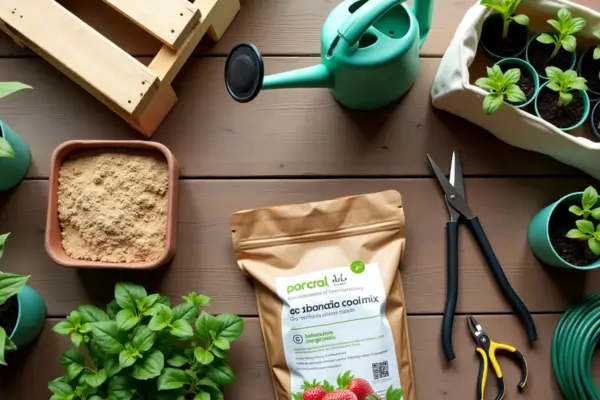
2-Essential Supplies for Your First Vertical Garden
Starting a vertical garden is exciting—but before you plant, you’ll need the right tools and materials. Don’t worry; you won’t need expensive equipment. Many supplies can be upcycled or found at local hardware stores. Here’s your beginner-friendly checklist:
1. Containers & Structures
Your garden’s “foundation” determines what and how much you can grow. Options include:
- Wooden Pallets (upcycled into rustic planters)
- Hanging Pots & Baskets (for trailing plants like cherry tomatoes)
- PVC Pipes (drilled with holes for a modular hydroponic setup)
- Fabric Pocket Planters (affordable, space-saving, and great for herbs)
- Repurposed Items (plastic bottles, shoe organizers, tin cans—get creative!)
Tip: Match the container size to your plant’s roots. Shallow pockets work for herbs, while deeper crates suit tomatoes.
2. Soil Mix
Vertical gardens need lightweight, well-draining soil to prevent waterlogging and reduce stress on walls/structures.
- Ideal blend: Coconut coir + compost + perlite (holds moisture without becoming heavy).
- Avoid: Dense garden soil (it compacts and strains supports).
Pro Hack: For pocket planters, mix in water-retaining crystals to reduce frequent watering.
3. Plants for Vertical Growth
Not all plants thrive vertically. Start with these easy, space-efficient choices:
- Herbs: Basil, mint, thyme, parsley (fast-growing and compact).
- Leafy Greens: Lettuce, spinach, kale (shallow roots = perfect for pockets).
- Fruiting Plants: Strawberries, cherry tomatoes, peas (use trellises or hanging baskets).
- Flowers: Nasturtiums, pansies (add color and attract pollinators).
Avoid: Heavy plants (like pumpkins) or deep-rooted veggies (carrots, potatoes).
4. Basic Tools
You likely have most of these already:
- Drill & Screws (for securing pallets or wall mounts).
- Hooks & Brackets (to hang containers securely).
- Watering Can with a Long Spout (or a drip irrigation kit for easy care).
- Scissors/Pruners (for harvesting and trimming).
Bonus: A pH tester (under $10) helps monitor soil health, especially for edible plants.
Final Tip: Start Small!
You don’t need everything at once. Begin with one container type (like a shoe organizer) and 2–3 easy plants (basil + lettuce). Expand as you gain confidence!
Next Up: Let’s dive into simple DIY vertical garden ideas you can build this weekend!
3-Easy Vertical Garden Ideas for Beginners
Ready to start your urban permaculture journey? These simple, low-cost vertical garden ideas are perfect for beginners. No fancy tools or skills required—just creativity and a little DIY spirit!
A. Pallet Garden
♻️ Upcycle a wooden pallet into a rustic vertical planter
- How to:
- Secure landscape fabric to the back and sides to hold soil.
- Fill with a lightweight potting mix.
- Plant herbs (thyme, oregano), succulents, or compact veggies (radishes, green onions).
- Best for: Balconies, patios, or fences.
- Pro Tip: Lean it against a wall or mount it vertically for stability.
B. Hanging Bottle Planters
💧 Turn plastic bottles into self-watering planters
- How to:
- Cut a bottle horizontally, poke drainage holes, and invert the top (like a funnel).
- Add soil and plant herbs (basil, mint, parsley).
- Hang with twine or hooks near a sunny window.
- Best for: Small spaces—great for kitchens or balconies!
- Pro Tip: Use a wick (cotton rope) to draw water from the reservoir below.
C. Shoe Organizer Garden
👟 Transform a fabric shoe organizer into a pocket garden
- How to:
- Hang on a fence, railing, or wall.
- Fill pockets with soil and plant leafy greens (lettuce, spinach) or strawberries.
- Best for: Renters—no drilling needed!
- Pro Tip: Water slowly to avoid soil spillage (or use a drip system).
D. Trellis & Climbing Plants
🌱 Grow vining plants upward for maximum yield
- How to:
- Install a trellis (bamboo, wire, or wood) on a wall or railing.
- Plant climbers like beans, peas, or cucumbers at the base.
- Best for: Sunny balconies or small yards.
- Pro Tip: Train vines with soft ties as they grow.
E. Stacked Crate Planters
📦 Use wooden or plastic crates for a tiered garden
- How to:
- Stack crates (secure with brackets if unstable).
- Line with landscape fabric, fill with soil, and plant tomatoes, peppers, or flowers.
- Best for: Deep-rooted plants in compact spaces.
- Pro Tip: Paint crates for a colorful touch!
F. Wall-Mounted Felt Pockets
🌿 Lightweight, modular, and perfect for herbs
- How to:
- Mount felt panels on a wall or fence.
- Fill pockets with soil and plant herbs (cilantro, chives) or small flowers.
- Best for: Indoor kitchens or shaded balconies.
- Pro Tip: Group plants with similar water needs (e.g., all drought-tolerant herbs).
Final Advice:
Start with one project (like the shoe organizer or bottle planters) and expand as you learn. Each of these ideas takes under 2 hours and costs less than $20!
Next Up: Tips for maintaining your vertical garden like a pro!
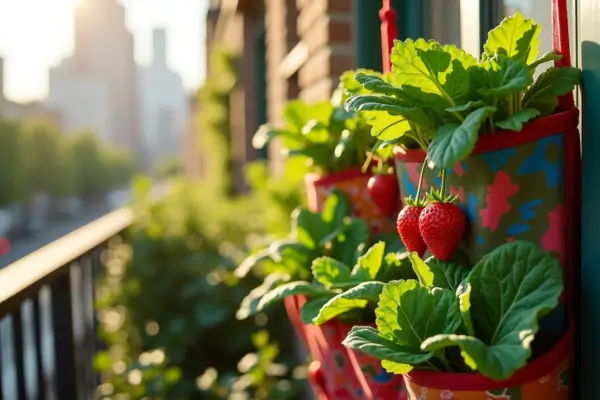
4- Effortless Vertical Garden Ideas for Urban Beginners
Transform your small space into a thriving green oasis with these simple, budget-friendly vertical garden solutions. Perfect for urban permaculture newbies, each idea requires minimal tools and maximum creativity!
A. The Rustic Pallet Planter
(Perfect for upcyclers & small-space gardeners)
🌱 What to Grow:
- Compact herbs (thyme, oregano, sage)
- Succulents (for low-water options)
- Quick-growing veggies (radishes, green onions)
🔨 Simple Steps:
- Line the pallet with landscape fabric to contain soil
- Fill with lightweight potting mix
- Plant in the slats or top opening
- Lean securely against a wall or mount vertically
💡 Pro Tip: Water gently at first – the soil may settle!
(Visual idea: Imagine a pallet bursting with fragrant herbs)
B. Self-Watering Bottle Planters
(Ideal for windowsill gardens & beginners)
🌿 Best Plants:
- Kitchen herbs (basil, mint, parsley)
- Microgreens
- Small flowers (pansies, violas)
✂️ Easy Assembly:
- Cut plastic bottles in half
- Invert tops to create self-watering reservoirs
- Add wicking material (cotton strips)
- Hang in sunny spots
🚰 Water Smart: Fill reservoirs weekly for constant moisture
(Picture: Colorful bottles lining a sunny balcony rail)
C. The No-Tools Shoe Organizer Garden
(Perfect for renters & apartment dwellers)
🥬 What Thrives Here:
- Leafy greens (lettuce, spinach, kale)
- Strawberries (yes, really!)
- Compact flowers (marigolds, nasturtiums)
👟 Setup in Minutes:
- Hang organizer on fence/railing
- Fill pockets with potting mix
- Plant directly in fabric pockets
⚠️ Watch Out: Water slowly to prevent soil washout
(Imagine: A lush green “curtain” of edible plants)
D. Space-Saving Trellis System
(For vertical veggie lovers)
🌽 Top Climbers:
- Pole beans & peas
- Cucumbers & mini melons
- Flowering vines (morning glories)
🏗 Installation Tips:
- Choose materials: bamboo, wire grid, or repurposed ladders
- Secure firmly to wall or railing
- Plant at base and train vines upward
✂️ Maintenance: Use soft ties to guide growth
(Visual: A balcony rail transformed into a green bean tunnel)
E. Stacked Crate Planters
(Great for deeper-rooted plants)
🍅 Ideal Crops:
- Cherry tomatoes
- Peppers
- Bush zucchini
- Colorful annual flowers
📦 Assembly Guide:
- Stack 2-3 crates securely
- Line with fabric to retain soil
- Plant different varieties in each level
🎨 Creative Touch: Stain or paint crates to match your decor
(Imagine: A vibrant tower of edible and ornamental plants)
F. Modular Felt Wall Garden
(For stylish herb gardens anywhere)
🌶️ Perfect Plants:
- Culinary herbs (chives, cilantro, rosemary)
- Edible flowers
- Compact chili peppers
🧵 Installation:
- Mount felt panels on any vertical surface
- Fill pockets with light soil mix
- Mix and match plants
💦 Watering Hack: Use a spray bottle for gentle watering
(Picture: A living wall of fresh herbs in a sunny kitchen)
Getting Started Tips:
- Start small – Try just 1-2 methods first
- Right plant, right place – Match plants to sunlight conditions
- Water wisely – Vertical gardens dry out faster
- Have fun! – There are no mistakes, just learning opportunities
Ready to grow up? Which vertical solution calls to you? Share your plans below!
Next in Series: “Vertical Garden Care: Simple Maintenance for Busy Urban Gardeners”
5- Best Plants for Urban Vertical Gardens: A Beginner’s Guide
Choosing the right plants is key to vertical gardening success! These space-efficient, easy-to-grow options will thrive in your urban garden while maximizing every inch of your vertical space.
Top Plant Choices for Vertical Growth
🌿 Herbs (Perfect for Small Spaces)
These aromatic plants grow beautifully in pockets, bottles, and small containers:
- Basil – Fast-growing and perfect for sunny spots
- Thyme – Drought-tolerant and great for beginners
- Cilantro – Grows quickly for continuous harvests
- Mint – Vigorous grower (best in contained spaces)
- Parsley – Biennial that keeps giving
Pro Tip: Plant herbs together based on water needs – Mediterranean herbs (thyme, rosemary) need less water than basil and parsley.
🥬 Leafy Greens (Ideal for Shallow Planters)
Conclusion
Start Your Vertical Garden Adventure Today!
Vertical gardening is the perfect solution for urban dwellers who crave fresh greens but lack space. By growing up instead of out, you can:
✔ Maximize tiny balconies, walls, and windowsills
✔ Grow your own food with minimal effort
✔ Create a beautiful, sustainable oasis in the heart of the city
Remember: Every expert gardener started as a beginner. Don’t overthink it—just pick one simple project (like the shoe organizer herb garden or bottle planters) and let your green thumb grow from there!
🌿 Now we’d love to hear from you! Which vertical garden idea excites you most? Will you try:
- The rustic pallet planter?
- Space-saving hanging bottles?
- No-fuss shoe organizer garden?
- Or another creative approach?
Share your plans below—we can’t wait to see what you grow!

